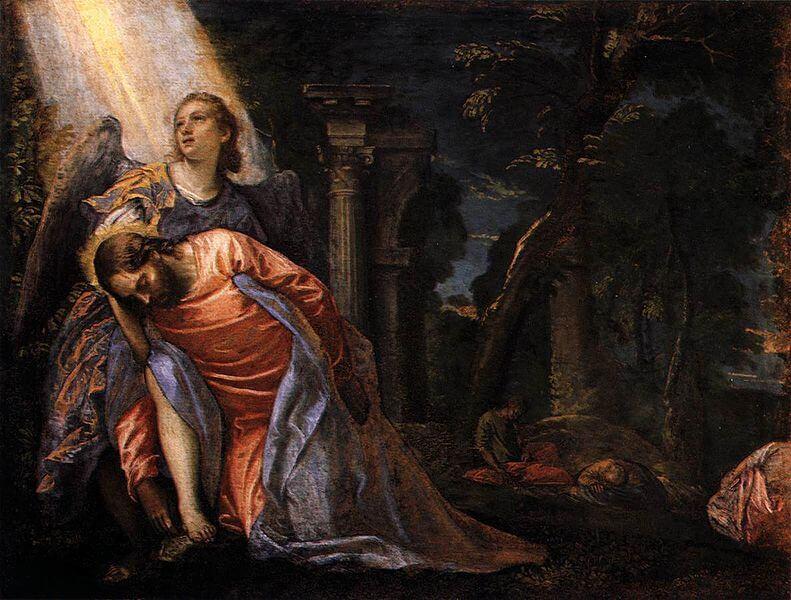Agony in the Garden
First Sorrowful Mystery of the Rosary

Introduction to Jesus' Agony
The Agony in the Garden holds profound importance in Christian theology. This pivotal event occurs in the Garden of Gethsemane, where Jesus, on the eve of His crucifixion, experiences intense emotional and spiritual anguish.
The significance of this sorrowful mystery lies in the humanity of Jesus. In the garden, He grapples with the weight of humanity’s sins, sweating drops of blood as He prays, “Father, if you are willing, take this cup from me; yet not my will, but yours be done.” This moment showcases Jesus’ acceptance of His divine mission and the sacrificial journey ahead.
Moreover, Jesus’ Agony foreshadows the upcoming Passion, emphasizing the redemptive power of Christ’s suffering. It marks the beginning of Jesus’ journey to Calvary, underscoring His willingness to bear the burdens of humanity’s sins for the sake of salvation.
This sorrowful mystery invites believers to reflect on the depth of Christ’s sacrifice and the magnitude of His love. It serves as a poignant reminder of the intersection between divine will and human suffering, laying the foundation for the transformative events that follow in the Passion of Christ. Jesus’ Agony sets the stage for the ultimate act of redemption, making it a profoundly significant and contemplative moment in the Christian faith and ultimately in the history of the world.
Scriptures
And going out, he went, according to his custom, to the mount of Olives. And his disciples also followed him.
And when he was come to the place, he said to them: Pray, lest ye enter into temptation. And he was withdrawn away from them a stone’s cast; and kneeling down, he prayed, Saying: Father, if thou wilt, remove this chalice from me: but yet not my will, but thine be done. And there appeared to him an angel from heaven, strengthening him. And being in an agony, he prayed the longer. And his sweat became as drops of blood, trickling down upon the ground.
And when he rose up from prayer, and was come to his disciples, he found them sleeping for sorrow. And he said to them: Why sleep you? arise, pray, lest you enter into temptation. (Luke 22:39-46)
Scripture Commentary
Jesus’ Agony is told in Luke 22:39-46. This moment in Christ’s Passion shows His full humanity and His perfect obedience. It also teaches how to face suffering with faith, prayer, and trust in God’s will.
Jesus Seeks His Father in Prayer
Verse 39: “And going out, he went, according to his custom, to the mount of Olives. And his disciples also followed him.”
Jesus did not run from what was coming. He did what He always did—He prayed. This tells us something right away: when facing trouble, go to prayer. Jesus chose the Mount of Olives. This was not a secret spot. Judas knew it well. Jesus knew Judas would come, but He still went.
This shows that Jesus faced His suffering on purpose. He was not caught by surprise. He entered the garden ready to suffer and ready to obey the Father.
Warning to the Disciples in the Garden
Verse 40: “And when he was come to the place, he said to them: Pray, lest ye enter into temptation.”
Jesus warned His disciples that temptation was near. They needed strength, and prayer was the only way to get it. Jesus was about to suffer, but He was thinking of them. He did not say, “Help me.” He said, “Pray for yourselves.”
This is a pattern for all of us. When the pressure rises, temptation grows stronger. And without prayer, we fall fast.
The Chalice of Jesus' Suffering and His Will to Obey
Verses 41–42: “And he was withdrawn away from them a stone’s cast; and kneeling down, he prayed, Saying: Father, if thou wilt, remove this chalice from me: but yet not my will, but thine be done.”
Jesus went a little farther alone. He dropped to His knees and begged the Father. What did He ask? That the cup of suffering might pass. This shows His human fear. Jesus knew every pain that was coming—betrayal, scourging, mockery, nails, the Cross. He asked to be spared, but only if the Father willed it.
This was not weakness. It was full surrender. “Not my will, but thine be done.” He gave up His will for ours. He would carry our sins, though it would cost Him everything.
This teaches us how to pray in trials. It’s okay to ask for relief. But we must end with, “Thy will be done.”
Heaven Sends Strength in an Angel
Verse 43: “And there appeared to him an angel from heaven, strengthening him.”
God heard the prayer. He did not take away the suffering, but He sent strength. An angel came to comfort Jesus. This shows the Father did not abandon Him. He was with Him in the pain.
God deals with us the same way. He may not take away the cross, but He gives us what we need to carry it. He sends help in many forms—grace, people, peace, or inner strength.
A Deeper Agony
Verse 44: “And being in an agony, he prayed the longer. And his sweat became as drops of blood, trickling down upon the ground.”
Jesus suffered not just physically but spiritually. The weight of the world’s sins pressed on Him. He saw every evil act, every cold heart, every lost soul—and still chose the Cross.
He was in such strain that His sweat became like blood. This condition, called hematidrosis, is rare but real. It comes from extreme fear or pressure.
Jesus did not fake His pain. He truly felt sorrow to the depths of His soul. Yet He kept praying. This teaches us: Don’t stop praying just because you feel broken. Pray harder. God is close in that pain.
The Disciples Sleep
Verses 45–46: “And when he rose up from prayer, and was come to the disciples, he found them sleeping for sorrow. And he said to them: Why sleep you? arise, pray, lest you enter into temptation.”
Jesus came back and found them asleep. They weren’t just tired—they were worn out from sorrow. But Jesus still told them to rise and pray. He repeated His warning: “Pray, lest you enter into temptation.”
They needed prayer more than rest. And so do we. When grief makes us want to shut down, we must fight to stay awake spiritually. The devil waits for moments like that.
Peter would soon deny Christ. The others would run away. Their failure came not from hate, but from weakness. They didn’t pray.
What This Teaches Us
Prayer is not an option. Jesus Himself prayed. That tells us everything. Prayer is how we face fear and temptation.
God hears, even when He does not remove the trial. Jesus still suffered—but He was strengthened.
Jesus truly understands human sorrow. He was not acting. He felt it all—fear, stress, sadness, pain.
Obedience to God’s will is always the right choice. Even when it hurts. Even when it costs everything.
Spiritual sleep is dangerous. The enemy strikes when we stop watching and stop praying.
Feast of Corpus Christi
The Feast of Corpus Christi, also known as the Solemnity of the Most Holy Body and Blood of Christ, is a Christian celebration that emphasizes the real presence of the body and blood of Jesus Christ in the consecrated elements of the Eucharist. This feast is particularly significant in the Roman Catholic Church, and it occurs on the Thursday after Trinity Sunday (the eighth Sunday after Easter).
The Feast of Corpus Christi is marked by various rituals and observances, and while the specific mention of “Jesus’ Agony” is not a central part of the liturgy for Corpus Christi, the events surrounding the Last Supper, including Jesus’ Agony at Gethsemane, are integral to the understanding of the Eucharist. Here’s how these elements are connected:
- Last Supper and Institution of the Eucharist: The Last Supper, where Jesus shared a final meal with his disciples before his crucifixion, is a foundational event for the Feast of Corpus Christi. During this meal, Jesus instituted the sacrament of the Eucharist by taking bread and wine, blessing them, and sharing them with his disciples. This act is commemorated in the celebration of the Mass, where the consecration of bread and wine represents the body and blood of Christ.
- Real Presence: The belief in the real presence of Christ in the Eucharist is central to the Feast of Corpus Christi. Catholics believe that, through the process of transubstantiation, the consecrated elements become the actual body and blood of Jesus. This belief is rooted in Jesus’ words at the Last Supper.
- Eucharistic Processions: While the Agony in the Garden may not be explicitly mentioned during Corpus Christi celebrations, the procession of the Blessed Sacrament is a significant part of the feast. During this procession, the consecrated host, representing the body of Christ, is carried in solemnity through the streets. This public display symbolizes the journey of Jesus from the Last Supper to the Garden of Gethsemane and, eventually, to the Cross.
- Devotion and Reflection: The Feast of Corpus Christi provides an opportunity for believers to reflect on the sacrificial nature of Jesus’ death, his presence in the Eucharist, and the importance of the Communion meal. While Jesus’ Agony may not be explicitly addressed, the entire narrative surrounding the Passion of Christ is central to the theological understanding of the Eucharist.
In summary, while the Feast of Corpus Christi does not specifically focus on Jesus’ Agony, the events surrounding the Last Supper, Jesus’ agony in Gethsemane, and his sacrifice on the Cross collectively form the theological backdrop for the celebration of the Eucharist during this feast.
Download our Sorrowful Mysteries pdf Document
We have a Sorrowful Mysteries pdf available for your use. It is free to download and share. It can be printed and used for praying the Rosary and is an excellent aid for anyone, especially for beginners. The author still uses it to this day.
To view our Sorrowful Mysteries pdf page, click the link. To go straight to the pdf, click the button below.

Charles Rogers is a resident of South Carolina and a retired computer programmer by trade. Raised in various Christian denominations, he always believed in Jesus Christ. In 2012, he began experiencing authentic spiritual encounters with the Blessed Virgin Mary, which led him on a seven-year journey at her hand, that included alcohol addiction, a widow maker heart attack and death and conversion to the Catholic Faith. He is the exclusive author and owner of Two Percent Survival, a website dedicated to and created in honor of the Holy Mother. Feel free to email Charles at twopercentsurvival@gmail.com.

We strive to provide the most complete and highest quality material we can for you, our readers. Although not perfect,
it is our desire and prayer that you benefit from our efforts.

